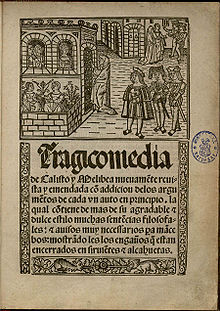This article needs additional citations for verification. (April 2013) |
 Title page | |
| Author | Fernando de Rojas |
|---|---|
| Original title | Comedia de Calisto y Melibea |
| Language | Spanish |
| Genre | Medieval novel |
| Publisher | Burgos |
Publication date | 1499 |
| Publication place | Spain |
| Media type | |
The Tragicomedy of Calisto and Melibea (Spanish: Tragicomedia de Calisto y Melibea), known in Spain as La Celestina is a work entirely in dialogue published in 1499. Sometimes called in English The Spanish Bawd, it is attributed to Fernando de Rojas, a descendant of converted Jews, who practiced law and, later in life, served as an alderman of Talavera de la Reina, an important commercial center near Toledo.
The book is considered to be one of the greatest works of all Spanish literature and is even the single topic of a Spanish literary journal, Celestinesca.[1] La Celestina is usually regarded as marking the end of the medieval period and the beginning of the renaissance in Spanish literature. Although usually regarded as a novel, it is written as a continuous series of dialogues and can be taken as a play, having been staged as such and filmed.[2]
The story tells of a bachelor, Calisto, who uses the old procuress and bawd Celestina to start an affair with Melibea, an unmarried girl kept in seclusion by her parents. Though the two use the rhetoric of courtly love, sex — not marriage — is their aim. When he dies in an accident, she commits suicide. The name Celestina[3] has become synonymous with "procuress" in Spanish, especially an older woman used to further an illicit affair, and is a literary archetype of this character, the masculine counterpart being Pandarus.
- ^ Lacarra, María Eugenia. "La parodia de la ficción sentimental en la" Celestina"." Celestinesca 13, no. 1 (1989): 11-29.
- ^ Snow, Joseph; Jane Schneider; Cecilia Lee (1976). "Un Cuarto de Siglo de Interes en La Celestina, 1949-75: Documento Bibliografico". Hispania. 59: 610–60. JSTOR 340648.
- ^ celestina in the Diccionario de la Real Academia Española Archived 2016-03-04 at the Wayback Machine